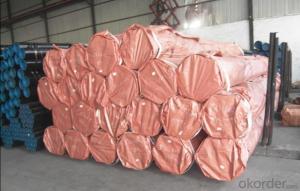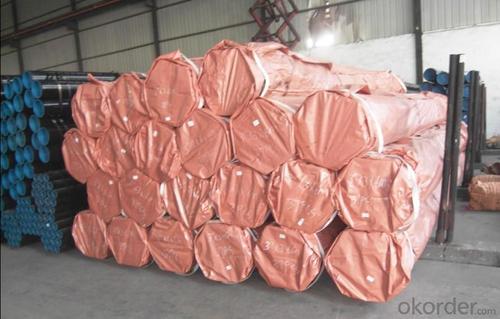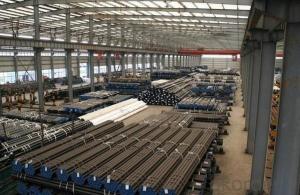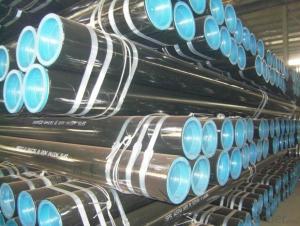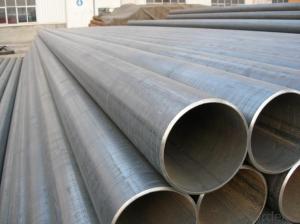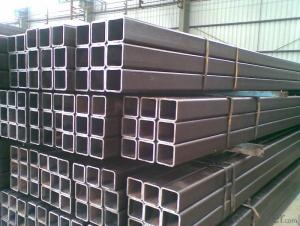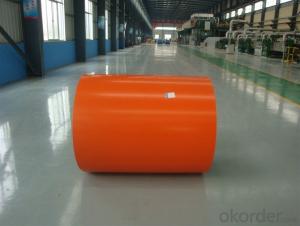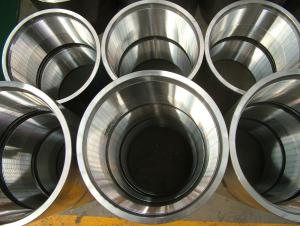Seamless Black Steel Pipe API PSL1/PSL2/X52
- Loading Port:
- Tianjin
- Payment Terms:
- TT or LC
- Min Order Qty:
- 25 m.t.
- Supply Capability:
- 9000 m.t./month
OKorder Service Pledge
OKorder Financial Service
You Might Also Like
1、Structure of Seamless Black Steel Pipe API PSL1/PSL2/X52:
Seamless pipe is formed by drawing a solid billet over a piercing rod to create the hollow shell. As the manufacturing process does not include any welding, seamless pipes are perceived to be stronger and more reliable. Historically seamless pipe was regarded as withstanding pressure better than other types, and was often more easily available than welded pipe.
2、Main Features of Seamless Black Steel Pipe API PSL1/PSL2/X52:
• High manufacturing accuracy
• High strength
• Small inertia resistance
• Strong heat dissipation ability
• Good visual effect
• Reasonable price
3、Seamless Black Steel Pipe API PSL1/PSL2/X52 Specification:
Standard | GB, DIN, ASTM ASTM A106-2006, ASTM A53-2007 |
Grade | 10#-45#, 16Mn 10#, 20#, 45#, 16Mn |
Thickness | 8 - 33 mm |
Section Shape | Round |
Outer Diameter | 133 - 219 mm |
Place of Origin | Shandong, China (Mainland) |
Secondary Or Not | Non-secondary |
Application | Hydraulic Pipe |
Technique | Cold Drawn |
Certification | API |
Surface Treatment | factory state or painted black |
Special Pipe | API Pipe |
Alloy Or Not | Non-alloy |
Length | 5-12M |
Outer Diameter | 21.3-610mm |
Grade | 20#, 45#, Q345, API J55, API K55, API L80, API N80, API P110, A53B |
Standard | ASME, ASTM |
1) Material:20#(ASTM A 106/A53 GRB.API5LGRB,GB),45#,16Mn,10#.
2) Specification range:OD:21.3-610mm,WT:6-70mm,length:6-12m or according to the requirement of clients.
3) Excutive standards:GB,ASME API5L.ASTM A 106/A53,Despite of the above standards,we can also supply seamless steel pipe with standard of DIN,JIS,and so on,and also develop new products according to the requirements of our clients!
4) Surface:black lacquered,varnish coating or galvanized.
5) Ends:Beveled or square cut,plastic capped,painted.
6) Packing:bundles wrapped with strong steel strip,seaworthy packing.
4、Packaging & Delivery
Packaging Details: | seaworthy package,bundles wrapped with strong steel strip |
Delivery Detail: | 15-30days after received 30%TT |
5、FAQ of Seamless Black Steel Pipe API PSL1/PSL2/X52:
①How is the quality of your products?
Our products are manufactured strictly according to national and internaional standard, and we take a test
on every pipe before delivered out. If you want see our quality certifications and all kinds of testing report, please just ask us for it.
Guaranteed: If products’ quality don’t accord to discription as we give or the promise before you place order, we promise 100% refund.
②How about price?
Yes, we are factory and be able to give you lowest price below market one, and we have a policy that “ for saving time and absolutely honest business attitude, we quote as lowest as possible for any customer, and discount can be given according to quantity”,if you like bargain and factory price is not low enough as you think, just don’t waste your time.Please trust the quotation we would give you, it is professional one.
③Why should you chose us?
Chose happens because of quality, then price, We can give you both.Additionally, we can also offer professional products inquiry, products knowledge train(for agents), smooth goods delivery, exellent customer solution proposals.Our service formula: good quality+good price+good service=customer’s trust
SGS test is available, customer inspection before shipping is welcome, third party inspection is no problem.
6、Seamless Pipe ASTM A106/53 Images:
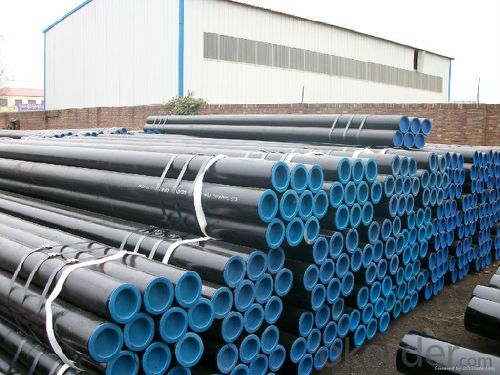
- Q: What type of steel pipe dance is used in general?
- The steel pipe fittings used in the pipe dance are made of smooth surface material, usually chrome or polished by steel or iron.
- Q: How can the immersed pipe pile put steel cage into the steel pipe? Which expert to answer?
- Cast-in-place pile for pile machine in place, hammer (vibration), on the edge of immersed tube material, hammer (vibration) side of extubation, and continue pouring concrete, steel cage, continue pouring concrete and extubation to pile.
- Q: How do you repair damaged steel pipes?
- To repair damaged steel pipes, there are several steps that can be followed: 1. Identify the extent of the damage: Assess the severity of the damage to determine if it can be repaired or if the pipe needs to be replaced altogether. 2. Isolate and drain the section: Shut off the water supply to the damaged section of the pipe and drain any remaining water to prevent further leakage or damage. 3. Clean the damaged area: Remove any dirt, rust, or other debris from the damaged area. This can be done using a wire brush or sandpaper. 4. Prepare the damaged area: Roughen the surface of the damaged area using coarse sandpaper. This will help the repair material adhere better to the pipe. 5. Choose a repair method: Depending on the size and location of the damage, there are various repair methods available. Some common options include using epoxy putty, pipe wraps, or clamps. 6. Apply the repair material: Follow the instructions provided with the chosen repair method to apply the material to the damaged area. Ensure that it covers the entire damaged section and extends slightly beyond it for added protection. 7. Allow the repair to cure: Give the repair material sufficient time to cure as per the manufacturer's instructions. This will ensure a strong bond and effective sealing of the damaged area. 8. Test the repair: Once the repair has cured, turn the water supply back on and check for any leaks. If there are no signs of leakage, the repair is successful. Otherwise, reevaluate the repair or consider seeking professional assistance. It is important to note that these steps provide a general guideline for repairing damaged steel pipes. However, the specific repair method may vary depending on the size and severity of the damage. In complex cases or if unsure, it is recommended to consult a professional plumber or pipe repair specialist.
- Q: What are the different types of steel pipe connections?
- The different types of steel pipe connections include threaded connections, welded connections, flanged connections, and grooved connections.
- Q: What are the different methods of pipe insulation for steel pipes?
- Various methods can be employed to insulate steel pipes, each offering distinct advantages and suitability for specific applications. Some commonly utilized techniques encompass: 1. Fiberglass insulation: Esteemed as a highly favored pipe insulation method, fiberglass insulation comprises fine glass fibers and is obtainable in diverse formats like rolls, sheets, or pre-formed sections. It boasts a lightweight nature, effortless installation, and exceptional thermal insulation attributes. 2. Foam insulation: Another efficacious means of insulating steel pipes is foam insulation, which can be procured in various forms including rigid foam boards or spray foam. It is renowned for its high insulating capacity and its ability to seal gaps and cracks, thereby enhancing energy efficiency. 3. Rubber insulation: Rubber insulation, also referred to as elastomeric insulation, is extensively employed in HVAC systems to insulate steel pipes. It possesses flexibility, durability, and resistance to moisture, making it suitable for both indoor and outdoor applications. Additionally, rubber insulation offers commendable thermal and acoustic insulation properties. 4. Polyethylene insulation: Polyethylene insulation presents a cost-effective alternative for insulating steel pipes. It can be found in diverse formats such as foam tubes or molded sections and is effortless to install. Polyethylene insulation provides commendable thermal insulation, safeguards against condensation, and exhibits resistance to water vapor diffusion. 5. Cellular glass insulation: Cellular glass insulation, a rigid insulation material produced from crushed glass and a foaming agent, is acknowledged for its exceptional thermal insulation attributes as well as its resistance to moisture, fire, and chemicals. It is commonly employed in cryogenic and high-temperature applications. When selecting the appropriate pipe insulation method for steel pipes, it is imperative to consider factors such as temperature, moisture conditions, and project-specific requirements. Seeking guidance from a professional or insulation expert can aid in determining the optimal insulation method based on the specific needs and conditions of the project.
- Q: How are steel pipes used in the manufacturing of automotive exhaust systems?
- Steel pipes are commonly used in the manufacturing of automotive exhaust systems as they possess high strength, durability, and resistance to heat and corrosion. These pipes are used to transport exhaust gases from the engine to the tailpipe, ensuring the safe and efficient operation of the vehicle. They are typically bent and welded together to create a complex network of pipes that helps direct the flow of exhaust gases and reduce noise levels. Overall, steel pipes play a crucial role in the construction of automotive exhaust systems, contributing to their reliability and longevity.
- Q: How do steel pipes handle pressure surges?
- Steel pipes are designed to handle pressure surges effectively due to their inherent strength and durability. The high tensile strength of steel allows it to withstand significant pressure fluctuations without deforming or bursting. Additionally, the seamless construction of steel pipes ensures a smooth and continuous flow, minimizing the impact of pressure surges. Furthermore, steel pipes can be reinforced with additional support structures, such as braces or anchors, to further enhance their ability to handle pressure surges.
- Q: What is the difference between cast iron and steel pipes?
- Cast iron and steel pipes are both commonly used in plumbing and construction applications, but they differ in several key aspects. 1. Composition: Cast iron pipes are made of a predominantly iron alloy, with small amounts of carbon and other elements. On the other hand, steel pipes are primarily composed of iron, but they also contain varying amounts of carbon and other alloying elements such as manganese, chromium, and nickel. 2. Strength: Steel pipes are generally stronger than cast iron pipes due to their higher carbon content and alloying elements. This makes steel pipes better suited for high-pressure applications or areas with heavy loads. 3. Flexibility: Steel pipes have more flexibility than cast iron pipes, allowing for easier installation and adjustment. Cast iron pipes, due to their brittleness, are less flexible and more prone to cracking or breaking if subjected to excessive stress or impact. 4. Corrosion resistance: Steel pipes are typically more susceptible to corrosion than cast iron pipes. However, this can be mitigated through various protective coatings or treatments applied to the steel pipes. Cast iron pipes, on the other hand, have inherent corrosion resistance due to the formation of a protective layer of rust on their surface. 5. Noise insulation: Cast iron pipes have excellent noise insulation properties due to their dense and heavy composition. This makes them ideal for applications where noise reduction is desired, such as in residential plumbing systems. Steel pipes, being lighter and less dense, do not offer the same level of noise insulation. 6. Longevity: Cast iron pipes have a long lifespan and can last for over 100 years when properly maintained. Steel pipes, while still durable, may have a shorter lifespan depending on factors such as the quality of the steel used, environmental conditions, and maintenance practices. In summary, the main differences between cast iron and steel pipes lie in their composition, strength, flexibility, corrosion resistance, noise insulation, and longevity. The choice between the two will depend on the specific requirements of the application, such as the desired strength, durability, and noise reduction properties.
- Q: How are steel pipes transported?
- Steel pipes can be transported using various methods depending on their size, weight, and distance to be covered. The most common modes of transportation for steel pipes include trucks, trains, and ships. For short distances, steel pipes are often transported using trucks. They are loaded onto flatbed trailers or in some cases, specialized pipe trailers that are specifically designed to securely hold and transport pipes. These trucks can easily navigate local roads and highways, making them a convenient option for transporting steel pipes to nearby locations or construction sites. When it comes to long-distance transportation, trains are commonly used. Steel pipes are loaded onto flatcars, which are specifically designed to carry heavy loads. This method is preferred when transporting large quantities of steel pipes over long distances, as trains provide a cost-effective and efficient means of transportation. Moreover, trains are capable of transporting pipes of various lengths and diameters, making them a versatile option. For international shipments or transportation over bodies of water, steel pipes are often transported by ships. Steel pipes can be loaded into shipping containers or onto the deck of a cargo ship. Shipping containers provide protection from weather conditions and ensure the pipes remain secure during transit. Additionally, specialized ships equipped with cranes can handle large and heavy pipes, facilitating the transportation of oversized steel pipes. In some cases, pipelines can also be constructed to transport steel pipes directly from the manufacturing facility to the desired location. This method is commonly used for projects involving oil, gas, or water pipelines. The pipes are laid underground, eliminating the need for separate transportation. Overall, the transportation of steel pipes involves a variety of methods, including trucks, trains, ships, and pipelines, depending on the distance, quantity, and specific requirements of the project. Each method has its advantages and is chosen based on factors such as cost, efficiency, and logistics.
- Q: What are the advantages of using steel pipes in the manufacturing of furniture?
- There are several advantages of using steel pipes in the manufacturing of furniture. Firstly, steel pipes provide durability and strength, ensuring that the furniture is sturdy and long-lasting. Secondly, steel pipes have a sleek and modern appearance, adding a contemporary touch to the furniture design. Additionally, steel pipes are resistant to corrosion, making them suitable for both indoor and outdoor furniture. Lastly, steel pipes are versatile and can be easily shaped and welded, allowing for customization and flexibility in furniture design.
Send your message to us
Seamless Black Steel Pipe API PSL1/PSL2/X52
- Loading Port:
- Tianjin
- Payment Terms:
- TT or LC
- Min Order Qty:
- 25 m.t.
- Supply Capability:
- 9000 m.t./month
OKorder Service Pledge
OKorder Financial Service
Similar products
Hot products
Hot Searches
Related keywords
